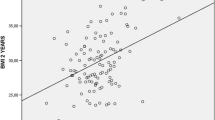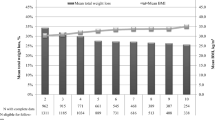Abstract
BMI and %EBMIL are the most accurate methods for comparing results of patients after bariatric surgery. %EBMIL is based on BMI 25 as a constant end-point for all patients, but BMI 25 is easily achieved by patients with BMI < 50, whereas it is not so feasible for patients with BMI > 50. We were prompted to obtain by statistical methods a mathematical formula able to calculate the final BMI (FBMI) 3 years after the operation, dependent on the initial or preoperative BMI (IBMI) of a multicenter group of morbid obese patients operated with different bariatric techniques. We also obtained a specific formula for each bariatric procedure of this group of patients. We propose the name Predicted BMI for the value obtained with these formulas and its application in the %EBMIL instead of the constant value of BMI 25. We have analyzed the IBMI and FBMI of a multicenter group of 7,410 patients, subjected to different bariatric procedures with a minimum follow-up of 36 months. Statistical methods with a linear regression model have been used to obtain the two types (global and specific) of Predicted BMI. We first obtained a general formula of \( {\hbox{PBMI}} = {\hbox{IBMI}} \times 0.4 + 11.75 \) for the total population of patients, and a second specific formula for each bariatric technique: \( {\hbox{PBMI}} = {\hbox{IBMI}} \times 0.43 + 13.25 + {\hbox{technique\_ correction\_ adjustment}} \) . Predicted BMI and its application to the %EBMIL may result in a more rational comparison of results of bariatric patients, bariatric techniques, and groups of bariatric surgeons. Predicted BMI may advance the BMI that each patient would probably achieve after surgery.



Similar content being viewed by others
References
Dixon J, Phail T, O’Brien PE. Minimal reporting requirements for weight loss: current methods not ideal. Obes Surg. 2005;15:1034–9.
Deitel M, Greenstein R. Editorial: recommendations for reporting weight loss. Obes Surg. 2003;13:159–60.
Deitel M, Gawdat K, Melissas J. Reporting weight loss 2007. Obes Surg. 2007;17:565–8.
Greenstein R. Reporting weight loss. Obes Surg. 2007;17:1275–6.
Baltasar A, Deitel M, Greenstein R. Letter to the Editor. Weight loss reporting. Obes Surg. 2008;18:761–2.
Baltasar A, Serra C, Bou R, et al. Original Índice de Masa Corporal esperable tras cirugía bariátrica. Expected body mass index after bariatric surgery. Cir Esp. 2009;86(5):308–12. http://www.elsevier.es/revistas/ctl_servlet?_f=7217&articuloid=13142594.
Baltasar A, Bou R, Bengochea M, Serra C, Perez N. Mil operaciones bariátricas.One thousand bariatric operations. Cir Esp. 2006;79:349–55.
Buchwald H. DM. Oien: metabolic/bariatric surgery worldwide 2008. Obes Surg. 2009;19:1605–11.
Metropolitan Life Insurance Company. New weight standards for men and women. Stat Bull Metrop Life Insur Co. 1959;40:1–10.
Metropolitan Life Foundation. Metropolitan Height and Weight Tables. Metropolitan Life Foundation Statistical Bulletin. 1983;64(1):2–9.
Committee S. American Society for Bariatric Surgery. Standards for reporting results. Obes Surg. 1994;4:56–65.
Committee S. American society for bariatric surgery. Guidelines for reporting results in bariatric surgery. Obes Surg. 1997;7:521–2.
Acknowledgements
None of the authors have potential conflicts of interest, including financial interests, relationships, and affiliations relevant to the subject of this manuscript.
We acknowledge the contribution with patient data, without any monetary compensation, from: Marceau P (Quebec City, Canada), Higa K (Fresno, CA, USA), Capella R (Hackensack, NJ, USA), Del Castillo J (Cali, Colombia), Weiner R (Frankfurt, Germany), Melissas J (Iraklion, Greece), Busetto L / Favretti F (Vicenza, Italy), Alarcó A (Tenerife, Spain), Blázquez C (Vitoria, Spain), Carbajo MA (Valladolid, Spain), Masdevall C (Barcelona, Spain), Davila D (Valencia, Spain), De la Cruz F (Madrid, Spain), De la Cruz JL (León, Spain), Martín Duce A (Madrid, Spain), Ferrer JV (Valencia, Spain), Ferrer M (Almeria, Spain), Martínez M (Zaragoza; Spain) Ortega J (Valencia, Spain) Ruiz JC (Getafe, Spain), Torres A (Madrid, Spain), Baltasar A (Alcoy, Spain).
Author information
Authors and Affiliations
Corresponding author
Rights and permissions
About this article
Cite this article
Baltasar, A., Perez, N., Serra, C. et al. Weight Loss Reporting: Predicted Body Mass Index After Bariatric Surgery. OBES SURG 21, 367–372 (2011). https://doi.org/10.1007/s11695-010-0243-7
Published:
Issue Date:
DOI: https://doi.org/10.1007/s11695-010-0243-7




